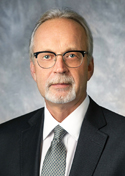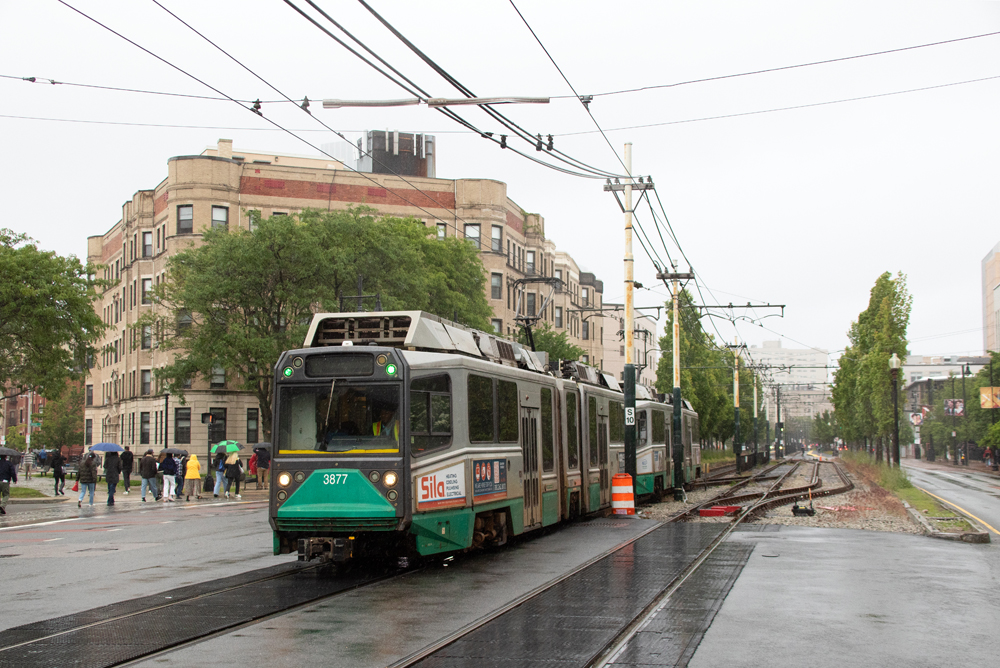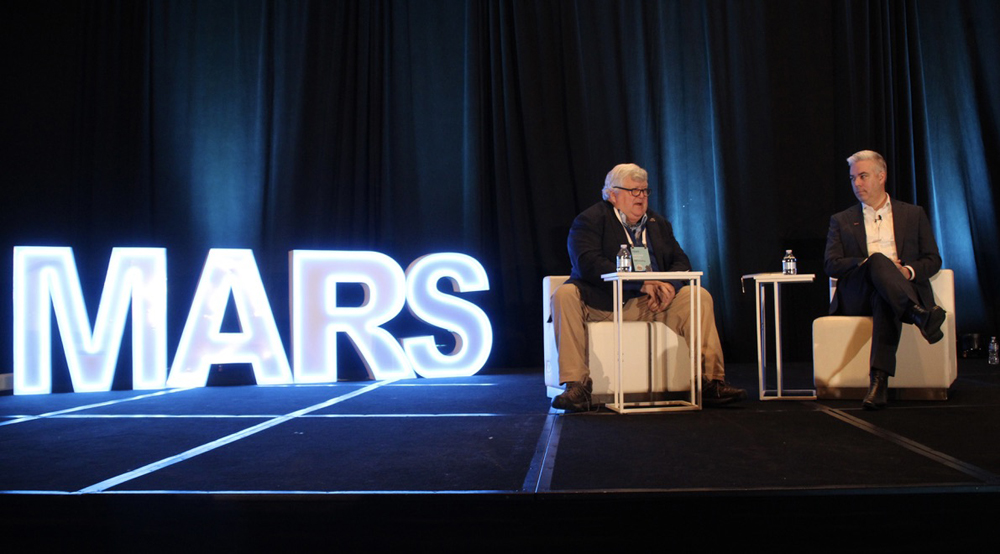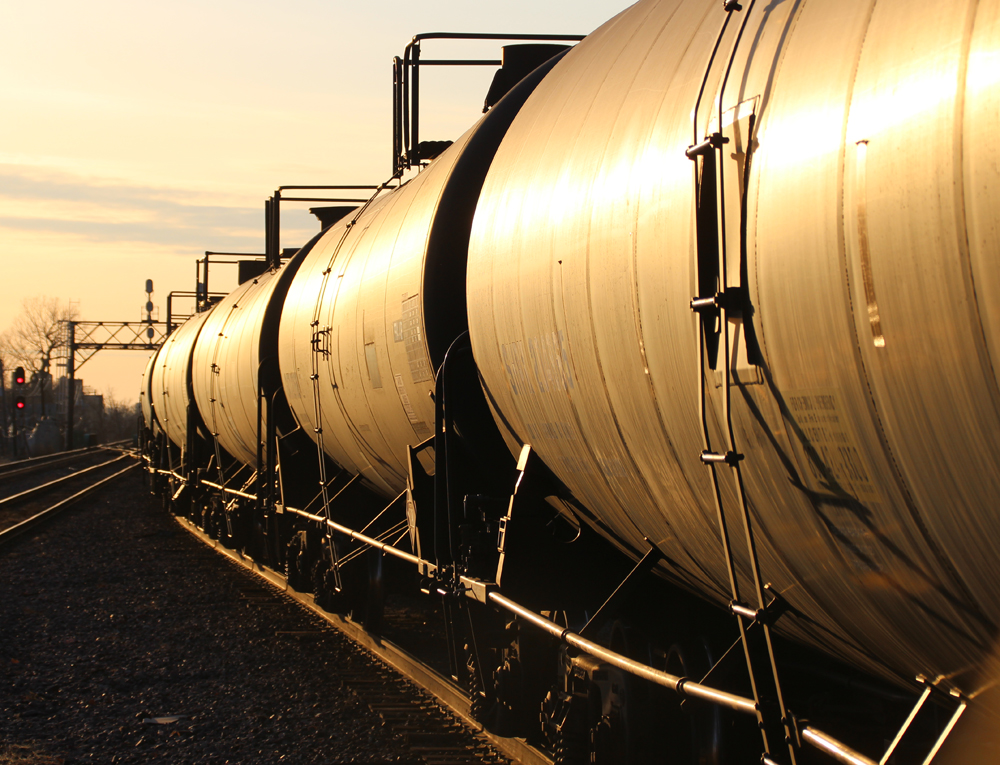In a symbolic move, Foote’s first decision after being named chief executive in December was ordering the hump bulldozed at Tilford Yard in Atlanta. The yard was one of eight humps converted to flat-switching last year under Harrison, who died in December.
“Atlanta hump yard today is flat,” Foote says. “There is no turning back.”
Foote made the remarks in the opening minutes of the railroad’s fourth-quarter earnings call on Jan. 16.
“Hunter was a true legend, and CSX would not be in the position it is today without the tremendous changes that he was able to make during his time here,” Foote says. “I am committed to seeing his vision through and making CSX the best railroad in North America.”
New operations chief Ed Harris, who joined CSX just last week, says the railroad will continue to follow Harrison’s operating plan, including running fewer trains, putting more locomotives in storage, moving the same tonnage with fewer freight cars, and having a more fluid network.
“The table has been set,” says Harris, who worked alongside Harrison at Illinois Central and Canadian National. CSX will take advantage of technology and boost the use of distributed power, Harris says.
Harris says he’s a proponent of run-through interchange trains and would like to see CSX bypass the Belt Railway of Chicago by running merchandise trains directly to BNSF Railway and Union Pacific.
Also on his agenda: Partnering with short lines and other Class I railroads to create shorter, more efficient routes as well as to take advantage of directional running opportunities, particularly for longer trains. CSX also will continue to build longer trains powered by fewer locomotives per train, Foote says. As CSX operations improve, a key focus is on boosting on-time performance, which was just 56 percent in the fourth quarter. That’s not satisfactory, Foote says, and the development of scheduling plans for every carload will help raise on-time deliveries.
Harrison changed as much at CSX in eight months as he did at CN in three years, Foote says. And CSX executives fully understand that the disruption caused by the rapid-fire implementation of Precision Scheduled Railroading came at the price of lost traffic, frayed customer relationships, and regulatory scrutiny.
Most of the traffic will eventually return to CSX, Foote says, citing Harrison’s experience changing CN and Canadian Pacific.
“We are seeing some of those customers return already,” Foote says, although the railroad expects revenue to increase only slightly this year.
But CSX neither wants nor expects to regain the 7 percent of domestic intermodal volume that left the railroad when it jettisoned its hub-and-spoke intermodal strategy. CSX had used its Northwest Ohio Intermodal Terminal as a container sorting hub to build density required to serve hundreds of low-volume lanes. Foote says the increasing amount of container traffic landing at East Coast ports is an intermodal opportunity that CSX will tap.
CSX slashed capital spending by 25 percent in 2017, to just more than $2 billion. It will fall by another 20 percent this year, to $1.6 billion. Analysts expressed concern over the sharp decline and asked whether CSX would be investing enough to maintain its physical plant.
The railroad will spend about $1.4 billion this year — roughly the same as in prior years — on track maintenance, Chief Financial Officer Frank Lonegro says.
The biggest reasons for the drop are the elimination of spending on new locomotives and freight cars. With 900 locomotives in storage, and 20,000 cars parked, it will be years before CSX needs to buy more, executives said.
Foote says the railroad is revisiting Harrison’s decision to pull out of the long-sought Howard Street Tunnel clearance project in Baltimore. The railroad is crunching the numbers again to see if there’s a business case for clearing the tunnel for double-stacks or whether there are other alternatives. Foote will let Maryland and Port of Baltimore officials know once a final decision has been made.
Citing an investor day scheduled for March 1, CSX executives would not provide many specifics regarding their expectations for 2018 and beyond.
They did say, however, that they expect significant improvement in the railroad’s operating ratio each of the next three years as operational improvements and efficiency gains flow to the bottom line.
Executives also expect CSX’s employee headcount to fall by 2,000 people this year. The company had 3,282 fewer employees on Dec. 31 than it did a year ago, as the workforce dipped to 24,006 people.
The total number of positions cut in 2017 hits 4,700 when consultants are included, Foote says.















Could you please provide a weekly ongoing discussion of the facts of Amtrak derailment south of Tacoma, Wa. I still have no idea of what the root cause of this accident. What is it going to take to have rapid transit between Vancouver, BC and San Diego, Ca.? I am no expert about this matter but I find hard to believe that passenger rail traffic would not believe more efficient than air traffic. There is no shortage of electric power along such a route so that it could be a significant reduction in the carbon footprint on the West Coast. With proper planning and real determination I would expect it would be faster, safer and cheaper than air travel. Part of our local issue is that no one agency is responsible for proper engineering of high speed rail along the eastern side of the western coastal mountain ranges. Tracks on the west side the mountains are significantly more susceptible to ground slippage due to earthquake movements resulting from the west coast subduction zone. The older route through some of the most beautiful coastal forest has been seriously damaged by the combination of ground movement and forest fires. I look forward to your future editorial comments.
Longer trains, less power, better on time performance, less capital spending. Do these guys listen to themselves?? Three years from now, CSX will look like Penn Central, if it takes that long. Glad I live next to the KCS.
I commented on one of these threads when EHH was still alive that I thought that it looked like he was sabotaging it to prime it for a merger.
Here in Indiana, we’ve seen the result of CSX’s and EHH’s idea of longer trains. On a regular basis, CSX brings trains into Indiana from Chicago, on the former GT main. When they arrive at Griffith Junction, they lock up the locomotive and leave the train on the main line, for a CN crew to arrive and take the train north to Kirk Yard on the lakefront. Meanwhile, as the train sits there unattended, it’s blocking main streets and highways and even interlocks with other railroads for long periods of time, sometimes requiring emergency vehicles to seek alternate routes. If CSX was interested at all about merchandise reaching it’s destination in a timely manner, they wouldn’t be parking these oversized trains for long periods of time, but instead working with other railroads on a better schedule so these trains don’t have to be standing someplace, and creating a nuisance.
Mark Harrison says “Dump hodgepodge trains on BNSF & UP and let them sort them out in Kansas City, Northtown and North Platte. “.
At least for UP, that would be consistent with their general hub-and-spoke manifest network. Making bypass blocks for a hump yard makes little sense – they are not designed for setouts and pickups, but rather, to terminate and originate trains. And UP generally does not do block swaps on the main routes, as it devours line capacity.
All CSX has to do is make a “NP and beyond” block.
Doug, all these CSX officers I worked with say they hear nothing but “Ayyeeee?” on these conference calls…!
Mr. Hensley, these “Canadians” you refer to are actually Americans.
Every other company looks to do more business
to increase the bottom line.not the hunter puppets.
17 days in the new year and they already have a number in their minds of how many to layoff.
Csx was doing pretty good till these “legends”
came to town. Let’s reinvent the wheel.
What a joke.
Hell yes, bean counter, tear it all apart! As a marketing man, what would you know about operations? These Canadians are used to a single-track, low-volume railroad. Even EHH cut his teeth on a minuscule Frisco and Illinois Central, before heading north of the border. You boys are in over your head; don’t expect the employees to throw you the hook.
I REALLY would LOVE to know how you can claim with your News Speak Department that:
1. putting hundreds of locomotives into cold storage
2. tearing up miles of double track
3. centralizing traffic control at one hurricane prone location
4. placing dispatching and scheduling in the hands of persons who have NEVER RIDDEN a mile of road in the cab of a diesel
5. firing most of the Next Generation to ensure that ALL institutional knowledge will be totally gone in 5 years AND any and all fresh ideas on taking back traffic back from the trucking companies will never be heard on the top floor
6. facilities for inter-modal traffic exchange are shuttered and/or torn down, instead of being modernized with robotics
7. the idea of bringing fresh blood into the company from college marketing programs is poo-pooed regularly
8. the hubris of ‘my way or the highway’ continues to make any ideas for improvements from some of the sensible employees, left over after Hatchet Man, still-born each and every day….
is somehow construed as ‘forward looking’.
just wondering….
Customers who return to a RR with a 56% on time record must be masochists.
Yesterday, I saw a 3-engine, 34 car train heading for Atlanta. Longer trains indeed.
Amen, Tom Stamey: Let’s all remember to look back a year from now and see who needs to eat crow.
Dear CSX Naysayers: CSX BOD has to ensure they carry out their fiduciary responsibilities to the share-holder, not the customer, nor work-force. As we watched the past seventy years of mergers, we discover how only the leanest & meanest survive.
To wit: how C&NW merged so many local grangers, ripping up their competing lines and abandoning customers – the farmer & their COOP’s along the now abandoned lines. That’s one typical example, where management, through this culling process of feeder/competing lines, became prime fodder for Uncle Pete to devour and enrich their share-holders in the end by becoming “lean & mean”. Remember, C&NW was at one time an “Employee Owned” RR, one that allowed itself to be shed to the investment community (enriching the share-holder – their own people) then subsequently being itself merged out of existence.
CSX is doing no less than what C&NW, and other industries have done. Another example, different industry. American Airlines engulfed TWA. They shuttered hubs (Saint Louis passenger/KC maintenance, etc.), streamlining (or as we now say, “leaning-out”) infrastructure in hopes of being a survivor. No luck; they were eaten by USAir (remember Allegany, Piedmont, and others that were the precursors of USAir?) once the AA route structure/infrastructure was rationalized. Ditto for Delta consuming Northwest (Orient); one can not stay with outdated methodologies, or infrastructure, if you hope to be a survivor.
Face it, there are still too many Class 1’s in the North American market (yes, I include NAFTA participants). Duopolies are the end-game, to satisfy U.S. government regulators desire to regulate; be damn those who want more than two Class 1’s, USA owned railroads left standing. In reality, BNSF is a winner, as are the two Canadian roads. The former because they have the deep pockets to consume either eastern road once the Regulators approve; Uncle Pete not so. The other winners are CN/CP. both of which operate coast-to-coast franchises, reaching into the U.S. on both accounts as well. No US road has such a luxury for they all have to hand-off to one another to reach the other coast.
Eliminating excess infrastructure to prepare CSX to either emerge as one who devours a western road (no chance there – not enough money even with hedge-fund support), or is devoured by BNSF, UP, or CP (sorry CN, you already got IC), is the final step prepping for the ultimate end-game. Remember the observation back in the 50’s: a pig can travel coast-to-coast without changing cars…. Both eastern roads realize there is a final merger wave a coming; which one will be more desirable to a partner? One with excess capacity or one with a streamlined infrastructure.
No one will pick the bloated one…. CSX is simply playing catch-up to what NS already began years earlier.
(p.s: for those who dislike my observation, I miss my vinyl, then reel-2-reel onto 4/8 track then cassette tapes, followed by CD (what an improvement) too; but I now realize MP3 is almost all that’s left for my musical entertainment. Miss the vinyl; sure. But progress will always TRUMP obsolescence (thinly veiled joke here). I foresee the present administration being very friendly to de-regulation of the railroads during the next 3 or 7 year, allowing the final Class 1 mergers to happen. I’ll miss the losers much as my beloved PM, C&O, GTW, AA, PRR, MC from my Michigan childhood.)
Trains should repeat this news column next year on what is written in support of CSX and see if any of the “forward looking” statements have any reality.
There’s no turning back from the damage they’ve already done.
Foote and company have no intention of making CSX a leading class I RR. As soon as they milk all they can out of the stock- they will start selling routes piece by piece.
CSX is run by a hedge fund- Harrison, Foote and Harris were/are all mouthpiece shills for Mantle Ridge.
Look for a large class action lawsuit against CSX in the coming months for violating federal law pertaining to the Family and Medical Leave Act.
Customers are not the only lineside folks affected by the CSX overhaul. Even towns that are not much more than a post office are having difficulties.
http://www.northwestgeorgianews.com/calhoun_times/on-the-wrong-side-of-the-tracks-railroad-woes-stir/article_eaced794-f21c-11e7-916a-67239fcb6849.html
Longer trains with fewer locomotives? A really, really bad idea particularly along the RF&P Subdivision from Crossroads Interlocking to Virginia Avenue in downtown DC. Simply put these extra long trains have caused nothing but headaches to commuters on VRE trains every time one breaks into two or more sections, or has to cross from one track to another. On more than one occasion delays of up to two hours have resulted for VRE trains when one of those monster CSX freights breaks a knuckle or two. Even worse is when a draw head is involved. To make matters worse the third track project from Arkendale to Powells Creek is currently dead in the water due to the Commonwealth of Virginia running out of money for the project. For the time being the third track is ending at North Possum Point Interlocking north of Quantico. No work is even being done on the section to finish what was started two years ago at this time.
Now there is an idiot if I have ever seen one. The bottleneck known as Atlanta will be flat switched in this resurging economy.
I am reading a blue print for disaster. What company would not want more business? Note earnings are up even with flat revenue and slumping traffic. Geeez. Terrible. I think all Foote and company want is a run through railroad. The ghost of EHH is leading everyone over the cliff at CSX. It is only the money, the rest of the railroad be damned.
Gads, what a wreck. “Let’s make sure our railroad can never grow again!” And as others have already noted, how do longer, underpowered trains lead to better timekeeping and customer satisfaction?
To hell with the customers! Let them eat cake! God help CSX. This mess will get worse.
“Have longer trains with less number of locomotives”. And they say they will speed up longer freight trains! Bull. Engines fail. Less horsepower on trains means slow downs going up hills and longer recovery time for speed. That simply does not increase speed. They claim with all the cars they have stored they will not need to buy any cars for years. You know what, the 40 year rule on car frames runs whether you use them or they sit still. Exception, non interchange cars.
All I see is customers, should we say trapped customers, will still be angry. But, everyone will be told “we are doing great”. Whether the customers are happy or not, Wall Street will be. And, of course, we exist to satisfy Wall Street !
How does longer (and I assume slower) trains with fewer locomotives make a railroad more efficient?
When following where EHH went, better watch where you step and have on Muck boots.